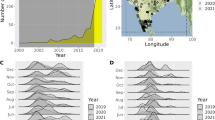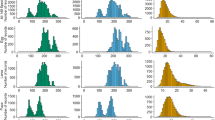Abstract
Many insects such as the crop pest Agrotis ipsilon (black cutworm) migrate seasonally to exploit suitable breeding and winter habitats. The migration of a crop pest also increases the risk of sudden outbreaks. Knowledge about insect migration thus is important for developing a forecasting and warning system for migratory pests. Here we used directional flight devices to study the orientation behavior of A. ipsilon in China during the northward and southward migratory periods and showed that the insects during each period exhibited a common cardinal orientation. Northward migratory moths were oriented at an orientation angle mean of 24.4° and the southward at 205.17°. Expression levels of cryptochrome and magnetoreceptor genes in migratory populations were higher than in a reared population and higher in the southward migratory population than in the northward. These findings provide a physiological and molecular basis for further study of the migratory behavior of the black cutworm and potential control of this pest.




Similar content being viewed by others
References
Chang H, Fu XW, Zhao SY, He LM, Hou YM, Wu KM (2017) Molecular characterization, tissue, and developmental expression profiles of MagR and Cryptochrome genes in Agrotis ipsilon (Lepidoptera: Noctuidae). Ann Entomol Soc Am 110:422–432
Chapman JW, Reynolds DR, Mouritsen H, Hill JK, Riley JR, Sivell D, Smith AD, Woiwod IP (2008) Wind selection and drift compensation optimize migratory pathways in a high-flying moth. Curr Biol 18:514–518
Chapman JW, Reynolds DR, Wilson K (2015) Long-range seasonal migration in insects: mechanisms, evolutionary drivers and ecological consequences. Ecol Lett 18:287–302
Clites BL, Pierce JT (2017) Identifying cellular and molecular mechanisms for magnetosensation. Annu Rev Neurosci 40:231–250
Dingle H (1996) Migration: the biology of life on the move, 2nd edn. Oxford University Press, New York
Dingle H, Drake VA (2007) What is migration? Bioscience 57:113–121
Dodson CA, Hore PJ, Wallace MI (2013) A radical sense of direction: signalling and mechanism in cryptochrome magnetoreception. Trends Biochem Sci 38:435–446
Dominik H, Martina M, Harald L, Onur G, Henrik M (2007) A visual pathway links brain structures active during magnetic compass orientation in migratory birds. PLoS One 2:e937
Elsalamouny S, Lange M, Jutzi M, Huber J, Jehle JA (2003) Comparative study on the susceptibility of cutworms (Lepidoptera: Noctuidae) to Agrotis segetum nucleopolyhedrovirus and Agrotis ipsilon nucleopolyhedrovirus. J Invertebr Pathol 84:75–82
Emlen ST, Emlen JT (1966) A technique for recording migratory orientation of captive birds. Auk 83:361–367
Feng HQ, Wu KM, Cheng DF, Guo YY (2004) Spring migration and summer dispersal of Loxostege sticticalis (Lepidoptera: Pyralidae) and other insects observed with radar in northern China. Environ Entomol 33:1253–1265
Feng HQ, Wu KM, Ni YX, Cheng DF, Guo YY (2006) Nocturnal migration of dragonflies over the Bohai Sea in northern China. Ecol Entomol 31:511–520
Feng HQ, Zhao XC, Wu XF, Wu B, Wu KM, Cheng DF, Guo YY (2008) Autumn migration of Mythimna separata (Lepidoptera: Noctuidae) over the Bohai Sea in northern China. Environ Entomol 37:774–781
Feng HQ, Wu XF, Bo W, Wu KM (2009) Seasonal migration of Helicoverpa armigera (Lepidoptera: Noctuidae) over the Bohai Sea. J Econ Entomol 102:95–104
Fu XW, Liu YQ, Li C, Lu YH, Li YH, Wu KM (2014) Seasonal migration of Apolygus lucorum (Hemiptera: Miridae) over the Bohai Sea in northern China. J Econ Entomol 107:1399–1410
Gao YB, Hu G, Zhai BP (2014) The effect of converted magnetic field on orientation behavior of armyworm moths Mythimna separata (Walker). Chin J Appl Entomol 51:899–905
Gegear RJ, Casselman A, Waddell S, Repper SM (2008) Cryptochrome mediates light-dependent magnetosensitivity in Drosophila. Nature 454:1014–1018
Gegear RJ, Foley LE, Casselman A, Reppert SM (2010) Animal cryptochromes mediate magnetoreception by an unconventional photochemical mechanism. Nature 463:804–807
Giunchi D, Baldaccini NE (2004) Orientation of juvenile barn swallows (Hirundo rustica) tested in Emlen funnels during autumn migration. Behav Ecol Sociobiol 56:124–131
Guerra PA, Gegear RJ, Reppert SM (2014) A magnetic compass aids monarch butterfly migration. Nat Commun 5:4164–4172
Guo JL, Fu XW, Wu X, Zhao XC, Wu KM (2015) Annual migration of Agrotis segetum (Lepidoptera: Noctuidae): observed on a small isolated island in northern China. PLoS One 10:e0131639
Haque R, Chaurasia SS, Rd WJ, Iuvone PM (2002) Dual regulation of cryptochrome 1 mRNA expression in chicken retina by light and circadian oscillators. Neuroreport 13:2247–2251
He HW, Zhang AL (1994) The application of fisher method to dividing seismicity perion in Yunnan province. J Seismol Res 17:231–239
He LM, Fu XW, Huang YX, Shen XJ, Sun XT, Wu KM (2018) Seasonal patterns of Scotogramma trifolii Rottemberg (Lepidoptera: Noctuidae) migration across the Bohai Strait in northern China. Crop Prot 106:34–41
Hendrix WH, Showers WB (1992) Tracing black cutworm and armyworm (Lepidoptera: Noctuidae) immigration using Pithecellobium and Calliandra pollen. Environ Entomol 21:1092–1096
Hu G, Lim KS, Reynolds DR, Reynolds AM, Chapman JW (2016) Wind-related orientation patterns in diurnal, crepuscular and nocturnal high-altitude insect migrants. Front Behav Neurosci 10:32
Jia PH (1985) A brief report on long distance migration and mark-recapture of cutworm, Agrotis ipsilon Rott. in China. Plant Prot 11:20
Lefeldt N, Dreyer D, Schneider NL, Steenken F, Mouritsen H (2015) Migratory blackcaps tested in Emlen funnels can orient at 85 degrees but not at 88 degrees magnetic inclination. J Exp Biol 218:206–211
Lemic D, Drmić Z, Bažok R (2016) Population dynamics of noctuid moths and damage forecasting in sugar beet. Agric For Entomol 18:128–136
Li W (2016) The transcriptome sequencing and gene expression analysis of migrant and resident Mythimna separata (Walker). Master Dissertation, Chinese Acadamy of Agricultural Sciences
Liu YQ, 2015. Migration and natal origins of Agrotis ipsilon (Lepidoptera: Noctuidae) over the Bohai Sea. Doctoral Dissertation, Chinese Academy of Agricultural Sciences
Liu YQ, Fu XW, Feng HQ, Liu ZF, Wu KM (2015) Trans-regional migration of Agrotis ipsilon (Lepidoptera: Noctuidae) in north-East Asia. Ann Entomol Soc Am 108:519–527
Liu YQ, Fu XW, Mao LM, Xing ZL, Wu KM (2016) Host plants identification for adult Agrotis ipsilon, a long-distance migratory insect. Int J Mol Sci 17:e851
Livak KJ, Schmittgen TD (2001) Analysis of relative gene expression data using real-time quantitative PCR and the 2-ΔΔCt method. Methods 25:402–408
Meister M (2016) Physical limits to magnetogenetics. Elife 5:e17210
Mouritsen H, Hore PJ (2012) The magnetic retina: light-dependent and trigeminal magnetoreception in migratory birds. Curr Opin Neurobiol 22:343–352
Mouritsen H, Ritz T (2005) Magnetoreception and its use in bird navigation. Curr Opin Neurobiol 15:406–414
Muheim R, Phillips JB, Åkesson S (2006) Polarized light cues underlie compass calibration in migratory songbirds. Science 313:837–839
Nohr D, Paulus B, Rodriguez R, Okafuji A, Bittl R, Schleicher E, Weber S (2017) Determination of radical-radical distances in light-active proteins and their implication for biological magnetoreception. Angew Chem Int Ed 56:8550–8554
Oliveira EG, Dudley R, Srygley RB (1998) Do neotropical migrant butterflies navigate using a solar compass? J Exp Biol 201:3317–3331
Pang KL, You H, Chen YB, Chu PC, Hu MQ, Shen JY, Guo W, Xie C, Lu B (2017) MagR alone is insufficient to confer cellular calcium responses to magnetic stimulation. Front Neural Circuit 11:e11
Perez SM, Taylor OR, Jander R (1997) A sun compass in monarch butterflies. Nature 387:29
Qin SY, Yin H, Yang C, Dou YF, Liu ZM, Zhang P, Yu H, Huang YL, Feng J, Hao JF (2016) A magnetic protein biocompass. Nat Mater 15:217–226
Reppert SM, Zhu H, White HR (2004) Polarized light helps monarch butterflies navigate. Curr Biol 14:155–158
Reppert SM, Gegear RJ, Merlin C (2010) Navigational mechanisms of migrating monarch butterflies. Trends Neurosci 33:399–406
Ritz T, Adem S, Schulten K (2000) A model for photoreceptor-based magnetoreception in birds. Biophys J 78:707–718
Schaefer GW (1976) Radar observations of insect flight. In: Symposia of the Royal Entomological Society of London, London
Shi XY, Feng HQ, Liu ZF, Li JD (2010) Comparative studies on orientation behaviors of Mythimna separata, Helicoverpa armigera, and Agrotis ipsilon in the laboratory. Plant Prot 36:60–63
Showers WB, Smelser RB, Keaster AJ, Whitford F, Robinson JF, Lopez JD, Taylor SE (1989) Recapture of marked black cutworm (Lepidoptera: Noctuidae) males after long-range transport. Environ Entomol 18:447–458
Srygley RB, Evandro G (2001) Sun compass and wind drift compensation in migrating butterflies. J Navig 54:405–417
Srygley RB, Oliveira EG, Woiwood IP, Reynolds DR, Thomas CD (2001) Orientation mechanisms and migration strategies within the flight boundary layer. In Woiwod IP, Reynolds DR and Thomas CD. Insect movement: mechanisms and consequences. CABI, Oxford, pp. 183–206
Srygley RB, Dudley R, Oliveira EG, Riveros AJ (2006) Experimental evidence for a magnetic sense in Neotropical migrating butterflies (Lepidoptera: Pieridae). Anim Behav 71:183–191
Tang QY (2010) DPS data processing system: experimental design, statistical analysis and data mining. Science Press, Beijing
Tomioka K, Matsumoto A (2010) A comparative view of insect circadian clock systems. Cell Mol Life Sci 67:1397–1406
Walker MM (2008) A model for encoding of magnetic field intensity by magnetite-based magnetoreceptor cells. J Theor Biol 250:85–91
Wan GJ, Jiang SL, Zhao ZC, Xu JJ, Tao XR, Sword GA, Gao YB, Pan WD, Chen FJ (2014) Bio-effects of near-zero magnetic fields on the growth, development and reproduction of small brown planthopper, Laodelphax striatellus and brown planthopper, Nilaparvata lugens. J Insect Physiol 68:7–15
Winklhofer M, Mouritsen H (2016) A magnetic protein compass? bioRxiv 094607
Wu X, Fu XW, Guo JL, Zhao XC, Wu KM (2015) Annual migration of cabbage moth, Mamestra brassicae L. (Lepidoptera: Noctuidae), over the sea in northern China. PLoS One 10:e0132904
Xu JJ, Wan GJ, Hu DB, He J, Chen FJ, Wang XH, Hua HX, Pan WD (2015) Molecular characterization, tissue and developmental expression profiles of cryptochrome genes in wing dimorphic brown planthoppers, Nilaparvata lugens. Insect Sci 23:805–818
Xu JJ, Pan W, Zhang YC, Li Y, Wan GJ, Chen FJ, Sword GA, Pan WD (2017) Behavioral evidence for a magnetic sense in the oriental armyworm, Mythimna separata. Biol Open 6:340–347
Zhai BP (2005) What have we seen by entomological radar? Chin Bull Entomol 42:217–226
Zhan S, Merlin C, Boore JL, Reppert SM (2011) The monarch butterfly genome yields insights into long-distance migration. Cell 147:1171–1185
Zhan S, Zhang W, Niitepõld K, Hsu J, Haeger JF, Zalucki MP, Altizer S, Roode JCD, Reppert SM, Kronforst MR (2014) The genetics of monarch butterfly migration and warning colouration. Nature 514:317–321
Zhao BP, Zhang XX (1993) Behavior of airborne insects in their migratory process: a review. Chin J Appl Ecol 4:440–446
Zheng DB, Hu G, Yang F, Du XD, Yang HB, Zhang G, Qi GJ, Liang ZL, Zhang XX, Cheng XN (2014) Ovarian development status and population characteristics of Sogatella furcifera (Horváth) and Nilaparvata lugens (Stål): implications for pest forecasting. J Appl Entomol 138:67–77
Acknowledgments
This research was supported by the National Natural Sciences Foundation of China (grant number 31727901 and 31621064).
Author information
Authors and Affiliations
Corresponding authors
Additional information
Publisher’s Note
Springer Nature remains neutral with regard to jurisdictional claims in published maps and institutional affiliations.
Electronic supplementary material
ESM 1
(DOCX 17 kb)
Rights and permissions
About this article
Cite this article
Chang, H., Guo, J.L., Fu, X.W. et al. Orientation Behavior and Regulatory Gene Expression Profiles in Migratory Agrotis ipsilon (Lepidoptera: Noctuidae). J Insect Behav 32, 59–67 (2019). https://doi.org/10.1007/s10905-019-09714-z
Received:
Revised:
Accepted:
Published:
Issue Date:
DOI: https://doi.org/10.1007/s10905-019-09714-z




